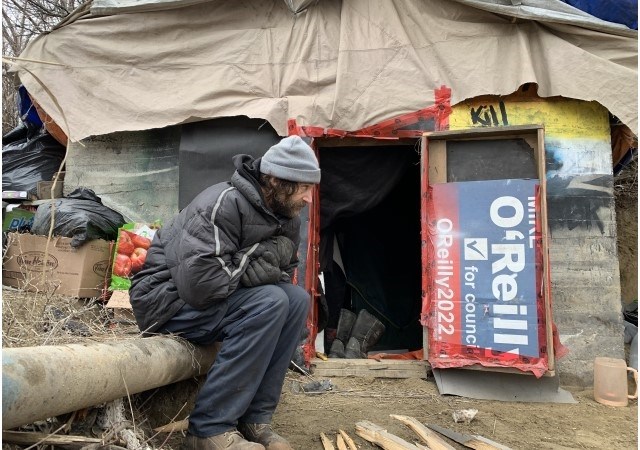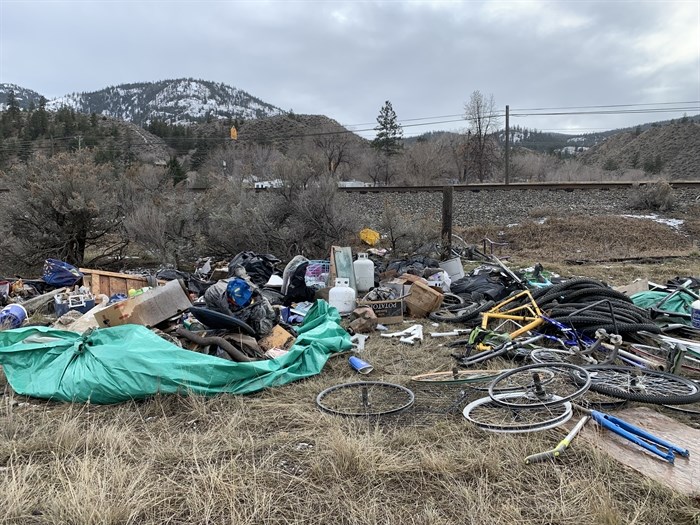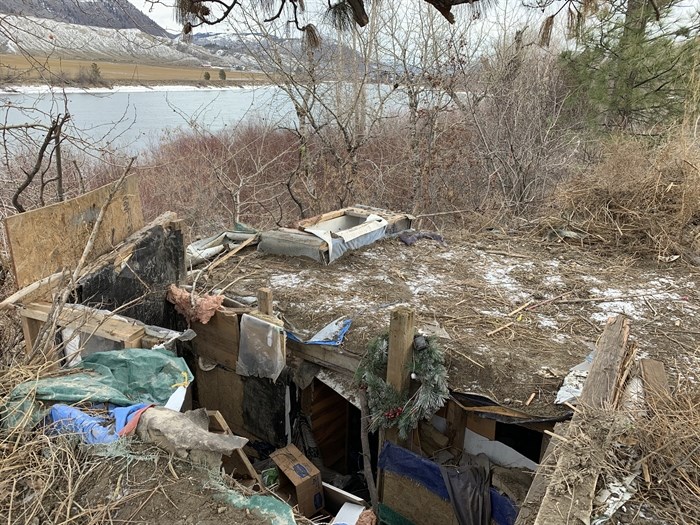
A homeless man's camps in Kamloops are more than just tents and tarps, but he was ousted from two in just a week in January 2025.
(LEVI LANDRY / iNFOnews.ca)
January 17, 2025 - 7:55 AM
To passersby and neighbours in heated homes, he's sitting on a trash heap, an eyesore that prompts calls to authorities.
But for Mike, the heap is his treasures and his sanctuary.
"I had everything I needed. It was warm, safe. It was my home," he said.
Far from the city centre and with a riverfront view, he repurposed what was once a shed or small barn into a home. He found the concrete foundation, walls and a dilapidated roof on the old Jimeva Farm in the Kamloops neighbourhood of Valleyview, insulated it and propped up a tent inside. It was his backup camp in the area for when bylaw officers oust him from his primary shelter, and they did earlier this week.
Now in his mid-50s, he has lived in Kamloops for most his life and spent the last five years homeless, though that’s not how he would describe it.
“They’re hurting people who are already hurt,” says Mike, the man who collected this stuff, assembled it and lived in it, after bylaw officers destroyed it. He wouldn't give permission to use his real name. He was expecting bylaw officers to return again and was gearing up to leave the second shelter within hours.
It was one of several re-purposed trash piles, organized and growing and sometimes outwardly dangerous, that got social media treatment from the people living in clean heated homes around him. This one’s in the Kamloops neighbourhood of Valleyview, but you can find them almost anywhere in this city and others. Wherever they are, they find conflict with people concerned about safety and the terrible mess.
The comments in the neighbourhood forums largely agree they should be gone, and the response when authorities are called can be swift.
Though the repurposed shed functioned as his home, complete with insulation, makeshift roof repairs and some lighting, his former camp was only recently trashed a short walk upriver.
He said he spent months digging, then reinforced it with walls and insulation. Two levels down on the banks of the South Thompson, his Tolkien-esque hobbit hole had two rooms, a skylight and a ladder entrance. It had two rooms and enough space to stand, with a raised bed on one side and an office chair with shelf space on the other. He also said it had a working generator.
Mike says he doesn't steal — he scavenges.
"People are stupid, they throw away, you know, a five-thousand dollar floor. Sure, I'll put it in my house," the former carpenter said.
He said he lived in that hole for four years until authorities removed him. It's now trashed, but most of its walled structure is still there.
Bylaw officers were so impressed with the camp they even called a building inspector to check on his work, he said.

The inside of what was a bedroom with a chair in the corner and skylight above. To the left and out of frame is a raised bed.
(LEVI LANDRY / iNFOnews.ca)
Homeless camps often draw neighbourhood attention over concern for property crime, but for nearby resident Darcy Anderson, it's the mess left behind.
"It's the environmental hazard," he said.
He often walks his dog in the beachfront strip that stretches from the east end of Valleyview nearly to Dallas. It's an 18-acre swath of land that's been poised for years to be turned to a park.
In recent years there have been several camps in the Valleyview grassland space between the South Thompson River and CN tracks, and they're often built well beyond tents and tarps, Anderson said.
"We had one a year ago that I reported. They had stolen enough materials from Orchards Walk that they had built probably ten separate rooms all joined together," he said.
Another, which burned down "a couple" years ago had solar power and a padlocked door. He said he contacted police and bylaws about it, but a week later it was in flames. Its remains are still just above the beach, including burnt debris and propane tanks.
Though the river is rarely high enough to reach the field above the beach, Anderson is dismayed at how much garbage and debris is still there after a camp is cleaned.
"My tax dollars are going to look after public property. I'd like to see it cleaned up. Nobody wants to see that mess. As a tourist too, if you come down here and you're taking your boat down the river, nobody wants to look over and see mattresses and chairs and garbage," Anderson said.

On Jan. 16, days after the resident was ousted from his camp, a trash heap remains near the tracks just between Valleyview and Dallas.
(LEVI LANDRY / iNFOnews.ca)
Bylaw manager Will Beatty said Community Service Officers are tasked with cleaning small amounts of garbage from camps when they're enforced or abandoned, while they routinely contact a contractor for the larger amounts.
"Never would we attend a camp, ask somebody to leave, follow up to find garbage that's left and allow that to stay because us, as stewards of the community, that's not normal practice for us," he said.
Mike's hobbit hole is now a trash heap, with walls in tact but filled in with boxes and trash. Closer to the railroad is a massive pile of tarps, boxes, bike parts and propane tanks. It appears no contractor has been around yet to clean it.
Beatty also said the bylaw enforcement to camps is always led with a "compassionate approach," but it's increasingly difficult when camps become entrenched for months and even more so when they go undetected, as the dug-in pit had.
"Our officers in most circumstances don't just show up and start tearing tarps and structures down, that's not our approach," he said.
The man's frustration with officers who removed him from his camp isn't a surprise to Beatty, but his presence in the area was known to the department for months before he was ousted.
"The disruption technique has worked in the past but it's not a solution to this. We try to come with a place of compassion to start and give as much time as we can, but with the understanding that our compassion can't be looked at as weakness," Beatty said.

The Tolkien-esque hobbit hole was complete with reinforced walls, insulation and a skylight, but on Jan. 16, 2025, it was filled with trash.
(LEVI LANDRY / iNFOnews.ca)
Though Mike moved to another camp still within the future park space, it's only temporary as he was warned by authorities he'll be moved along again.
He has spent years in the same Valleyview area, only venturing downtown for medical appointments and otherwise keeping distance from most of the other homeless camps that are more prevalent downtown and along the North Shore.
Forced to move again, he has no plans to try using a shelter and plans to build another camp instead.
City bylaws only allow temporary camps and only for designated areas. The rules dictate that permanent structures aren't allowed, and in addition to requiring they be taken down each day, camps are only allowed to be in central areas like downtown riverfront and along Schubert Drive. Valleyview is well outside those bounds.
Bylaw officers don't enforce those specific rules to the letter, though. Even in more urban areas of the city, some camps can last for weeks, despite the City's desire to keep them from becoming entrenched.
City officials have also been working with the federal government in an attempt to clean overgrowth along riverbanks, but the riparian zones are the Department of Fisheries and Oceans' responsibility and getting the process started has been slow.
Fire chief Ken Uzeloc told iNFOnews.ca in September the City wants to address erosion and fire risk along the riverbanks, but it's not clear whether an agreement with the federal government has been reached yet. It's also not clear whether riparian spaces as far as Valleyview and Dallas would be included in the management plan.
To contact a reporter for this story, email Levi Landry or call 250-819-3723 or email the editor. You can also submit photos, videos or news tips to the newsroom and be entered to win a monthly prize draw.
We welcome your comments and opinions on our stories but play nice. We won't censor or delete comments unless they contain off-topic statements or links, unnecessary vulgarity, false facts, spam or obviously fake profiles. If you have any concerns about what you see in comments, email the editor in the link above. SUBSCRIBE to our awesome newsletter here.
News from © iNFOnews, 2025